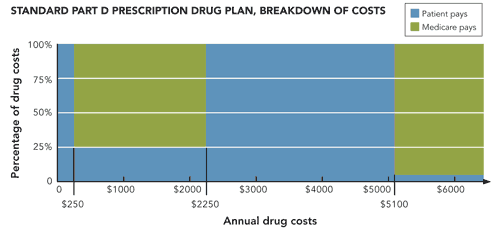
Understanding the basics will help you field patients’ questions about the new prescription drug benefit.
Fam Pract Manag. 2006;13(1):58-62

When a recent poll asked seniors where they would turn for help with Medicare’s Part D prescription drug benefit, their No. 1 answer was their doctor.1 Patients expect us to have answers to their questions about the new drug benefit, which was created by the Medicare Prescription Drug, Improvement and Modernization Act (MMA) of 2003. While the Centers for Medicare & Medicaid Services (CMS) does not expect doctors to have all the answers, it is our professional responsibility to understand the basics of the benefit so we can help our patients get the medications they need.
How does it work?
Starting in January 2006, private organizations contracting with CMS will begin to offer Medicare beneficiaries a number of prescription drug plans. These plans will include some stand-alone, prescription-drug-only plans and some Medicare Advantage plans that will include prescription drug coverage along with Part A and Part B coverage. Details of the plans in your area can be found at http://www.medicare.gov.
A standard prescription drug plan is structured as follows: Patients can buy prescription drug coverage for a monthly premium of about $37. After paying a $250 out-of-pocket deductible, participants must pay 25 percent of the cost of each medication until drug costs reach $2,250. Under the standard benefit, the individual then pays 100 percent of drug costs over $2,250 until the costs reach $5,100. At that point, patients begin paying 5 percent of drug costs (or $2 for generics and $5 for brand-name drugs) until the end of the year, when the cycle starts over. Premiums, deductibles and cost-sharing may all vary from plan to plan, but many follow this standard structure.
For a plan with a monthly premium of $37.50 to pay for itself, a patient’s annual drug costs would need to be greater than $850. For example, the beneficiary will pay approximately $450 in premiums plus the $250 deductible and then $150 of the next $600 worth of medications over the deductible. At this point, the individual has paid $850 out-of-pocket for $850 worth of medications. See “Standard Part D prescription drug plan, breakdown of costs” for coverage details.

Who should enroll?
All Medicare beneficiaries will be eligible to enroll in a Part D prescription drug plan. Open enrollment began on Nov. 15, 2005, and will last until May 15, 2006. Beneficiaries without creditable drug coverage who enroll after that date will be subject to a financial penalty (a 1-percent increase in premium for every month they were eligible but did not enroll).
Low-income beneficiaries. Those with low incomes (about one-third of the Medicare population2) can apply for a subsidy from the federal government (referred to by CMS as “extra help”). Individuals with an income less than $14,355 or couples with an income less than $19,245 will qualify for extra help if they also have savings, investments and real estate (not counting one home, car and funeral expenses) worth less than $11,500 for a single person or $23,000 per couple.2,3 Some states will offer programs with financial assistance to people with more resources. Encourage your patients with low incomes to take the following steps:
Apply for extra help through the Social Security Administration (SSA). Online applications for extra help are processed at http://www.ssa.gov/prescriptionhelp/.
In addition, some states will provide financial assistance to people who just miss qualifying for federal assistance. If patients are unsure whether they would qualify, encourage them to proceed with the SSA recommendation: “When in doubt, fill it out.”
Once approved to receive extra help, enroll in a Part D prescription drug plan. This can be done by contacting the drug plan, visiting Medicare’s Web site at http://www.medicare.gov or calling 1-800-MEDICARE.
Patients with low incomes will need to complete both steps listed above with the SSA and CMS to take advantage of all of their options. (See “Prescription drug plan enrollment process by type of Medicare beneficiary.”)
PRESCRIPTION DRUG PLAN ENROLLMENT PROCESS BY TYPE OF MEDICARE BENEFICIARY
| Estimated percent of Medicare population | Enrollment process | |
|---|---|---|
| Medicaid eligible beneficiaries (Dual eligibles) | 14 percent community residents; 61 percent long-term-care facility residents5 | Automatic, but beneficiary may switch plans if desired |
| Community-resident beneficiaries with drug coverage (non-Medicaid) | 34 percent with employer coverage5 12 percent with Medigap5 12 percent with Medicare HMOs5 10 percent with other public drug coverage5 | Voluntary, but beneficiary will receive a letter indicating whether current coverage is creditable |
| Beneficiaries in long-term-care facilities, with or without drug coverage | 6 percent5 | Voluntary, but beneficiary may need assistance choosing a plan (77.6 percent are cognitively impaired) |
| Low-income beneficiaries, with or without drug coverage (Not including Medicaid/dual eligibles) | 19 percent2 | Voluntary, but eligible for subsidy with application to SSA |
Medicaid eligible beneficiaries. Beginning Jan. 1, Medicaid ceased paying for prescription drugs for those also enrolled in Medicare, and coverage by the new Medicare plan began. Individuals enrolled in both Medicare and Medicaid (dual beneficiaries) have been automatically assigned a prescription drug plan, though they may change plans if they choose. Dual beneficiaries are the only people with the freedom to change plans out side of the “open enrollment” periods each year.
Beneficiaries with current drug coverage. A recent nationwide survey of employer-based prescription drug plans found that most were more generous than the plans offered by Medicare.4 For this reason, individuals with drug plans offered by an employer, the state or the military should not switch to a Medicare plan unless they receive a letter stating that their current coverage is “not creditable” (i.e., not as actuarially sound as a Medicare-sponsored plan). Those whose current plan is deemed not creditable will likely benefit from changing to a plan that meets Medicare’s standards. Patients with coverage deemed not creditable who do not change their plan by the end of the open enrollment period on May 15, 2006, will be subject to the financial penalty described earlier.
Beneficiaries in long-term-care facilities. About three-fourths (77.6 percent) of Medicare beneficiaries in long-term-care facilities have a documented cognitive impairment and will need assistance deciding whether to enroll in a Part D plan and in which plan to enroll.5 They will also need to select plans using specialized dispensing pharmacies that serve their facility.
Beneficiaries without drug coverage. Medicare beneficiaries without current drug coverage who do not qualify for extra help will need to decide if a Medicare drug plan will be worthwhile to them in the foreseeable future. As mentioned earlier, if patients plan on spending at least $850 out-of-pocket each year on prescription drugs, enrollment probably will be worth it. Because of the financial penalty for signing up late, it is advisable to enroll as soon as possible.

How will this affect your practice?
The most important things you can do for your Medicare patients are as follows: Tell them to watch their mail for information about prescription drug insurance, encourage them to apply to SSA for extra help if they might qualify, give them a printed list of their current medications and provide them with key contact information. Though your patients may ask for your assistance in choosing a plan, CMS does not expect physicians to have the time or training to do this. CMS depends on its own staff and partner organizations for outreach, education and enrollment.
Also, remember that your Medicare patients with full Medicaid benefits will be facing new formularies on Jan. 1, and some of these patients might switch formularies as often as monthly. This will likely place an extra burden on office staff who answer calls and faxes from pharmacies.
After patients have enrolled in a plan, some may need to change medications or brands to abide by their plan’s formulary. Expect some patients to bring you appeal letters to fill out, attesting that they need a medication that is not on their plan’s formulary.
Be aware that the MMA’s electronic prescribing provision calls on the National Committee on Vital and Health Statistics to work with CMS to create standards for e-prescribing (see http://ncvhs.hhs.gov/ for details). Physicians will not be required to e-prescribe, but prescription drug plans are required to make this option available by January 2009. This provision is intended to enable physicians, pharmacists and patients to coordinate personal medication lists easily and efficiently with the formulary of the plan of choice. To take advantage of this, physicians should have high-speed Internet access in the office.
CODING FOR VISITS RELATED TO PART D
Questions and prescription changes related to Part D coverage may produce longer visits with your Medicare patients. Kent Moore, the AAFP’s manager for health care financing and delivery systems, recommends capturing the extra time either by coding on the basis of time (assuming that counseling or coordination of care as defined by CPT consumes at least half of the face-to-face time that the physician spends with the patient) or by using the prolonged services codes, 99354-99355, as appropriate. Visits spent switching medications and rewriting prescriptions will need to be coded on the basis of history, exam and medical decision making, as usual.
Preparing for Part D
If they haven’t already, your Medicare patients soon will be coming to you with questions about Medicare Part D. For the questions you can’t answer, it is your job to point patients in the right direction. These new plans can provide them with much-needed prescription drug coverage. By learning as much as you can about Part D now, you will help your patients make the transition to the new coverage more effectively and efficiently.
WHERE TO TURN FOR ASSISTANCE
Given that millions of beneficiaries will have questions during the six-month window for initial enrollment (Nov. 15, 2005, to May 15, 2006), CMS has partnered with many national, regional, state and local organizations and programs to help educate people about this new benefit. State Health Insurance Programs (SHIPs) are currently training corps of volunteers to counsel seniors and other Medicare beneficiaries about how to choose a specific plan. Web sites, phone numbers and text telephone numbers for agencies qualified to assist are listed below.
| Organization | Contact information |
|---|---|
| Centers for Medicare & Medicaid Services (CMS) | http://www.medicare.gov/ (800-633-4227); TTY 877-486-2048 |
| State Health Insurance Assistance Programs (SHIPs) | https://shipnpr.shiptalk.org/shipprofile.aspx Site contains contact information for SHIPs in all states. |
| National Association of Area Agencies on Aging (AAA) and U.S. Administration on Aging (AoA) | http://www.eldercare.gov 800-677-1116 |
| Access to Benefits Coalition (ABC) | http://www.accesstobenefits.org/ 202-479-6670 |
| Benefits Check Up (A Service of the National Council on the Aging) | http://www.benefitscheckup.org 202-479-1200; TTY 202-479-6674 |
| Medicare Rights Center (MRC) | http://www.medicarerights.org New York: 212-869-3850; Washington: 202-589-1316 |
| Social Security Administration (SSA) (assistance with “extra help” only) | http://www.ssa.gov/prescriptionhelp/ 800-772-1213; TTY 800-325-0778 |